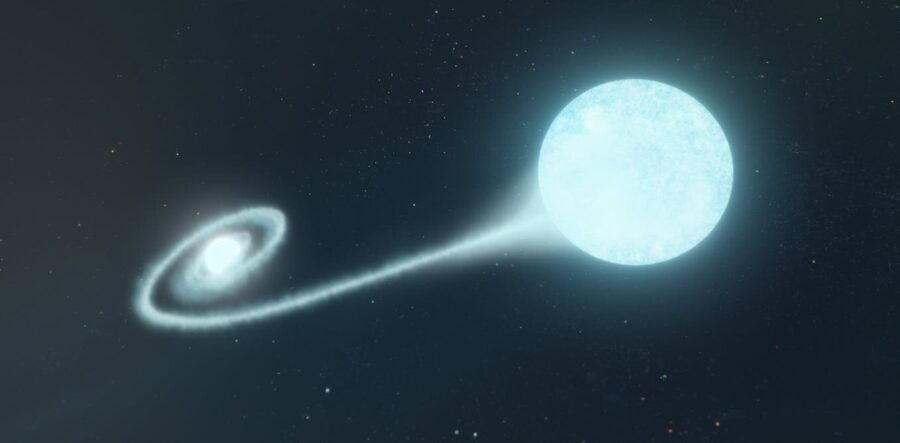
Adam Makarenko / W. M. Keck Observatory
Astronomers have observed an unusual supernova, in which a helium star fed a white dwarf until it exploded.
In March 2020, astronomers detected a supernova designated SN 2020eyj. They weren't particularly impressed at first — just one more among the thousand supernovae found each year. But then its strange behavior caught researchers’ attention.
The supernova was of Type Ia, indicating that a white dwarf had exploded when it became more massive than it could handle. Most white dwarfs cross this limit when they merge with a white dwarf companion — the so-called double-degenerate scenario. But more than 100 days after the detection, it became apparent that this supernova wasn’t behaving like most Type Ias.
Further observations, presented in Nature, reveal a rare specimen. For the first time, astronomers have caught a Type Ia supernova shining at radio wavelengths, which allowed them to understand what caused the explosion: This time, the white dwarf at the heart of the explosion had no compact companion.
TWO FORMATION CHANNELS
Type Ia supernovae mark cataclysmic deaths of white dwarfs, the compact remnants of low-mass stars. However, an isolated white dwarf, being incredibly stable, won’t explode on its own. Instead, it needs a companion to push it over the edge, either another white dwarf or a normal star. In the double-degenerate case, two white dwarfs spiral toward each other, eventually colliding in an explosion.
In the other case, known as the single-degenerate scenario, a white dwarf siphons gas from a companion star, gaining mass in the process. At some point, the white dwarf ignites and blows up. The evolution of such a system depends on the masses of the two stars and their separation. All the different possible evolutionary paths make it hard to assess how prevalent either scenario really is.
“It’s really hard when you start including all the channels,” says Ashley Ruiter (University of New South Wales, Australia), a supernova expert not involved in the study. “You’re going to get different predictions depending on what you assume in your models.”
Observationally, the number of clear-cut cases remains low. However, while companions are difficult to observe directly, they leave a signature on their surroundings (known as the circumstellar medium). And this is where SN 2020 eyj really shined.
FIRST RADIO DETECTION
About 100 days after detection, SN 2020eyj started emitting more visible light than expected, prompting interest. What’s more, special features in its spectrum revealed that the explosion's ejecta had crashed into the gas surrounding the star. Theory predicts that radio emission should eventually follow, produced by ejected electrons whirling around ambient magnetic fields, and that’s just what astronomers detected two years later. Astronomers had never seen such radio waves from a Type Ia supernova before.
"It's the first time that the radio detection allowed us to confirm the presence of the circumstellar medium," says Erik Kool (Stockholm University, Sweden), who led the study. The radio data showed dense gas far away from the exploding white dwarf, as expected if the companion was a normal star. The visible-light spectrum also revealed a lot of helium in the surrounding gas, suggesting that the companion was a helium star that had lost much of its material just before the white dwarf's explosion.
Ruiter says that the authors' argument, at face value, seems quite strong. “Type Ia supernovae involving a helium-rich donor are predicted from population synthesis,” says Ruiter. Her own simulations predicted that this scenario would account for only 10% of all single-degenerate formation channels, so it’s a rare find
Then again, SN 2020eyj was already faint when it started behaving strangely, so astronomers may have missed the similar, more distant explosions. To catch more single-degenerate cases, astronomers have to find a way to recognize such events early on.
Comments
Post a Comment